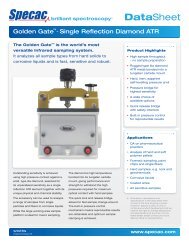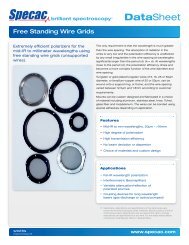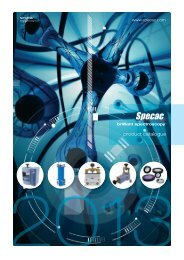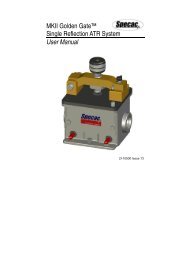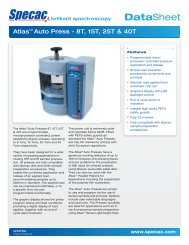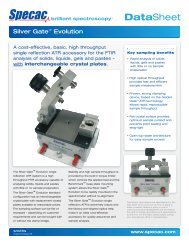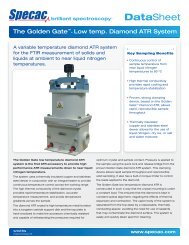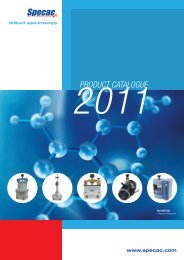2012 Product Catalogue
2012 Product Catalogue
2012 Product Catalogue
Create successful ePaper yourself
Turn your PDF publications into a flip-book with our unique Google optimized e-Paper software.
Specac <strong>Product</strong> <strong>Catalogue</strong> <strong>2012</strong> | Spectroscopist’s Hints and Tips<br />
Spectroscopist’s Hints and Tips<br />
The following hints and tips on Infrared Sampling may help you achieve better spectra with<br />
greater ease. Don’t forget to contact your local Specac representative if you need any help<br />
with your application. Contact details are listed at the back of this catalogue.<br />
Reflection Measurements<br />
Two ways of reducing the ATR penetration depth<br />
into a strongly absorbing sample are choosing an<br />
ATR crystal with a higher refractive index (see the<br />
list of optical material properties at the back of<br />
this catalogue), and selecting a larger angle of<br />
incidence.<br />
When analyzing powdered samples using ATR,<br />
pre-grinding the sample will improve the<br />
homogeneity of the sample particles, and yield<br />
better spectra.<br />
Aerosol spray samples can be conveniently<br />
analyzed using the ATR technique. Spray the<br />
contents onto a flat or trough top-plate, in a fume<br />
cupboard, away from the spectrometer<br />
compartment.<br />
Lacquers and coatings can be analyzed for<br />
specular reflectance in the following way. Wrap<br />
aluminium foil (shiny side out) around the<br />
reference mirror and apply the coating. Allow to<br />
dry and record spectra of the resulting film.<br />
When using diffuse reflectance the sample<br />
heights are not alway uniform. Each time the<br />
sample is changed it is desirable to reach the<br />
optimum height and peak energy as quickly as<br />
possible. A rolling micrometer on the Specac<br />
Minidiff Plus accessory adjusts the height in<br />
seconds, without using tools.<br />
Level the surface of a sample for diffuse<br />
reflectance measurement by gently tamping<br />
down the surface, using a glass slide resting on<br />
the surface under its own weight. Do not press<br />
the surface hard, and risk compacting the<br />
sample. The surface can be seen through the<br />
glass slide.<br />
www.specac.com<br />
110



